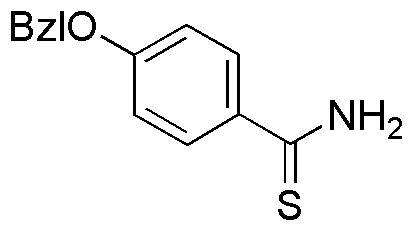4-Benzyloxy-thiobenzamide is widely utilized in research focused on:
- Pharmaceutical Development: This compound serves as a key intermediate in the synthesis of various pharmaceutical agents, particularly those targeting specific biological pathways.
- Organic Synthesis: It is employed in organic chemistry for developing complex molecules, offering a versatile building block for researchers in academia and industry.
- Biochemical Research: Used in studies investigating enzyme inhibition and receptor interactions, it helps researchers understand drug mechanisms and improve therapeutic efficacy.
- Material Science: The compound can be incorporated into polymer formulations, enhancing properties like thermal stability and mechanical strength, which is beneficial for creating advanced materials.
- Analytical Chemistry: It acts as a reagent in various analytical techniques, aiding in the detection and quantification of other compounds, thus supporting quality control in manufacturing processes.
General Information
Properties
Safety and Regulations
Applications
4-Benzyloxy-thiobenzamide is widely utilized in research focused on:
- Pharmaceutical Development: This compound serves as a key intermediate in the synthesis of various pharmaceutical agents, particularly those targeting specific biological pathways.
- Organic Synthesis: It is employed in organic chemistry for developing complex molecules, offering a versatile building block for researchers in academia and industry.
- Biochemical Research: Used in studies investigating enzyme inhibition and receptor interactions, it helps researchers understand drug mechanisms and improve therapeutic efficacy.
- Material Science: The compound can be incorporated into polymer formulations, enhancing properties like thermal stability and mechanical strength, which is beneficial for creating advanced materials.
- Analytical Chemistry: It acts as a reagent in various analytical techniques, aiding in the detection and quantification of other compounds, thus supporting quality control in manufacturing processes.
Documents
Safety Data Sheets (SDS)
The SDS provides comprehensive safety information on handling, storage, and disposal of the product.
Product Specification (PS)
The PS provides a comprehensive breakdown of the product’s properties, including chemical composition, physical state, purity, and storage requirements. It also details acceptable quality ranges and the product's intended applications.
Certificates of Analysis (COA)
Search for Certificates of Analysis (COA) by entering the products Lot Number. Lot and Batch Numbers can be found on a product’s label following the words ‘Lot’ or ‘Batch’.
*Catalog Number
*Lot Number
Certificates Of Origin (COO)
This COO confirms the country where the product was manufactured, and also details the materials and components used in it and whether it is derived from natural, synthetic, or other specific sources. This certificate may be required for customs, trade, and regulatory compliance.
*Catalog Number
*Lot Number
Safety Data Sheets (SDS)
The SDS provides comprehensive safety information on handling, storage, and disposal of the product.
DownloadProduct Specification (PS)
The PS provides a comprehensive breakdown of the product’s properties, including chemical composition, physical state, purity, and storage requirements. It also details acceptable quality ranges and the product's intended applications.
DownloadCertificates of Analysis (COA)
Search for Certificates of Analysis (COA) by entering the products Lot Number. Lot and Batch Numbers can be found on a product’s label following the words ‘Lot’ or ‘Batch’.
*Catalog Number
*Lot Number
Certificates Of Origin (COO)
This COO confirms the country where the product was manufactured, and also details the materials and components used in it and whether it is derived from natural, synthetic, or other specific sources. This certificate may be required for customs, trade, and regulatory compliance.


